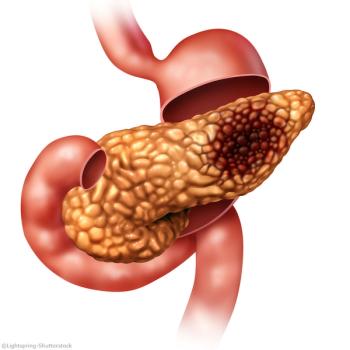
- ONCOLOGY Vol 18 No 6
- Volume 18
- Issue 6
Monoclonal Antibodies: The Foundation of Therapy for Colorectal Cancer in the 21st Century?
The manuscript written by Drs.Hoff, Ellis, and Abbruzzese isan outstanding overview of thedevelopment, mechanism of action,and key clinical data for bevacizumab(Avastin) and cetuximab (Erbitux).Over the past several years,the landscape for treating patients withcolorectal cancer has changed dramaticallywith the inclusion of irinotecan(Camptosar), oxaliplatin (Eloxatin),and capecitabine (Xeloda). Then, beforewe can even catch our breath,along come cetuximab and bevacizumab.The next several years will befocused on testing these agents in avariety of clinical trial settings to optimizetheir use for patients with colorectalcancers. Three issues come tomind after reviewing the Hoff et almanuscript: (1) semantics, (2) awkwardUS Food and Drug Administration(FDA) indications, and (3) money.
The manuscript written by Drs.Hoff, Ellis, and Abbruzzese isan outstanding overview of thedevelopment, mechanism of action,and key clinical data for bevacizumab(Avastin) and cetuximab (Erbitux).Over the past several years,the landscape for treating patients withcolorectal cancer has changed dramaticallywith the inclusion of irinotecan(Camptosar), oxaliplatin (Eloxatin),and capecitabine (Xeloda). Then, beforewe can even catch our breath,along come cetuximab and bevacizumab.The next several years will befocused on testing these agents in avariety of clinical trial settings to optimizetheir use for patients with colorectalcancers. Three issues come tomind after reviewing the Hoff et almanuscript: (1) semantics, (2) awkwardUS Food and Drug Administration(FDA) indications, and (3) money.Terminology Concerns
The authors of this manuscript andmany others refer to the novel agentsas "targeted" therapies. I find this terminologysomewhat problematic inthat we have long been in the era of"targeted therapies" when one takesinto account that the targets for chemotherapeuticagents have beenknown for several decades. While thismight be a semantic splitting of hairs,what we have entered is not really anera of targeted therapy but an era of"better targets." Molecular biologyresearch has identified a series of bettertargets distinguishing malignantcells from normal cells, widening ourtherapeutic advantage in treating patientswith cancer. The agents bevacizumaband cetuximab are wonderfuladditions to our expanding list ofagents directed against better targets.FDA Approvals:The Devil Is in the Details
The FDA granted approvals forboth bevacizumab and cetuximabwith relatively specific guidelines,which may have raised as many questionsas were answered. Bevacizumabwas approved for front-linemetastatic colorectal cancer in combinationwith intravenous fluorouracil(5-FU)-based regimens. The pivotaltrial for bevacizumab was performedin combination with the bolus 5-FU/leucovorin/irinotecan regimen developedby Len Saltz known as IFL.Since Dr. Saltz's landmark paper,however, several other events havealtered the optimum treatment of metastaticcolon cancer: (1) the developmentof oxaliplatin, (2) the suggestionthat infusion 5-FU is superior to bolus5-FU, and (3) the inclusion ofcapecitabine as an option for patientswith metastatic colon cancer.The wording of the FDA approvalallows us as clinicians to incorporatebevacizumab into any regimen utilizingintravenous fluorouracil eitheralone, in combination with irinotecan,or in combination with oxaliplatin,but excludes combinationswith capecitabine. The available clinicaltrial data available support a benefitwith the bolus IFL regimen, butthis leaves us unsure of the clinicalbenefit of adding bevacizumab to infusionfluorouracil regimens such asFOLFIRI and FOLFOX, and alsoleaves us wondering whether we willever give bevacizumab with capecitabine.In contrast to this relative freedomwe have been given with bevacizumab,cetuximab has been approvedonly in those patients with metastaticcolon cancers refractory to irinotecanthat express the epidermal growth factorreceptor. This is in the face ofsignificant data that suggest that EGFRexpression levels do not correlate withclinical outcomes. Given this restriction,it is important for oncologists todocument epidermal growth factorreceptor expression prior to the utilizationof cetuximab. Hopefully, asmentioned in the manuscript, data inpatients without EGFR expression willsupport a broadening of the utility ofcetuximab. Also, as the indication readstoday, we must first treat patients withirinotecan without cetuximab, havethem progress, and then add cetuximab.This treatment pathway seems somewhatcounterintuitive but we must waiton additional trial data to support anearlier use of cetuximab.Economic Factors
Finally, we as oncologists are underclose scrutiny when it comes tothe high cost of medical care, with thefocal point being colon cancer therapies.First, our standard regimens arevery expensive; second, bevacizumaband cetuximab will add further to thesecosts; and third, the finances of oncologyare undergoing dramatic,difficult to predict changes. In thisenvironment, it is unlikely that wewill be able to maintain the same degreeof therapeutic freedom we haveenjoyed in the past.Clearly, both bevacizumab andcetuximab will play a significant rolein the treatment of other cancer types,but the temptation to utilize these medicinesoff label must be balancedagainst our economic responsibilities.The risk is that the dramatic potentialof these agents will be overshadowedby a public outrage over costs. Onesolution is to increase clinical trialparticipation. This would be a way toexpand our understanding of theagents in other diseases, to expandaccess to other cancer types, and toexpand FDA approvals, while meetingthe expectations of third-party payers,the federal government, the media,and the public.Conclusions
In summary, we are delighted toenter the era of better targets for treatmentagainst cancer. We are pleasedby the rapid approval of these twonew effective agents in the treatmentof metastatic colon cancer, but mustbe highly cognizant of our economicresponsibilities as shepherds of thesenew agents for our patients with thisserious and common medical illness.Therefore, the data reviewed in themanuscript are vital for us to have athand as we incorporate these medicinesinto our daily practices.
Disclosures:
The author is involvedin consulting, speaking, and researchfor Roche, Pfizer, Sanofi, Genentech, andBoehringer Ingelheim.
Articles in this issue
over 16 years ago
Ginger quells chemotherapy-related nauseaover 21 years ago
Current Status of Adjuvant Therapy for Colorectal Cancerover 21 years ago
Current Status of Adjuvant Therapy for Colorectal Cancerover 21 years ago
Current Status of Adjuvant Therapy for Colorectal CancerNewsletter
Stay up to date on recent advances in the multidisciplinary approach to cancer.

























































































